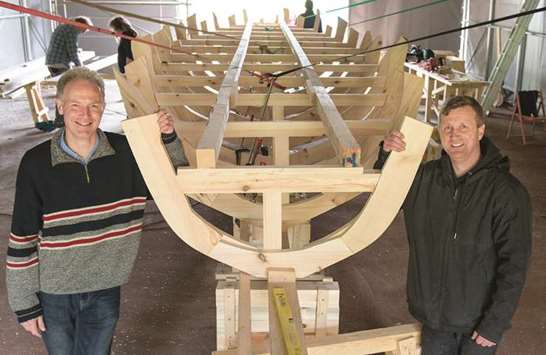A squeak of the saw and the splinters fly. The boat’s oak keel is already finished and soon they’ll begin fixing the wooden planks to the sides.
For a short time now, researchers have been building a replica of a Roman military ship in a sports hall in Erlangen, southern Germany.
It’s almost completely made of wood. The researchers, led by ancient history professor Boris Dreyer, hope to make new discoveries about ancient ship-building methods and how such boats were used in the Roman Empire.
It’s also an attempt to make history more tangible, a change from dusty books and gloomy lecture theatres.
Around 45 students, 16 school children and 90 volunteers are putting the boat together with the help of two professional shipbuilders.
History and politics student Johannes Nagy has been there from the very beginning. “It’s really special for me to be able to work on such an unusual project,” says the 19-year-old.
Aside from the idea, he also loves the chance to work with his hands, something that doesn’t happen often for a city boy like him.
“It’s fun, I’m learning something practical which will stand me in good stead. And it’s a nice change from everyday life at university, which obviously is mostly challenging for the mind,” he adds.
The shipbuilders are working to ancient specifications. “We can’t make it exactly as they did back then,” admits Dreyer. Without electrical equipment they couldn’t possibly meet their one-year deadline.
But they’re trying to stick as much as possible to the original design, which they’ve taken from two well preserved military ships from around 100AD that were discovered by archaeologists in 1986 near the ruins of a nearby Roman fort. Only the bow and the stern were missing.
Dreyer says the boats would have been used for patrols, as well as exploratory missions and for moving troops about quickly.
There are some questions that the researchers would like to have answered in particular: What rowing technique did the around 20 Romans on board use? How much strength did they need, how fast could the boat go and how far?
“To test it out we want to go down the Danube at least as far as the Black Sea,” says Dreyer. But there’s also a question of cost, he adds.
The researchers also want to try out different kinds of sails, and reconstruct the original paintwork.
“The war ships were incredibly brightly painted,” says Dreyer. The Romans wanted to “go down in style,” he says.
Researchers at the nearby University of Regensburg attempted in 2004 to sail a Roman river boat that they had reconstructed, and the University of Trier, in western Germany, has also tried something similar.
But the boats they built (navies lusoria) were modelled after boats that the Romans first used around 200 years after the ones that were discovered near Erlangen.
“Later isn’t necessarily better,” says Dreyer. Much of the shipbuilders’ knowledge was lost in the intervening period, he says.
The Mediterranean shipbuilding technique being used for the new boat is consistent with modern methods used for wooden boats today and would still be used if it weren’t so expensive, says Dreyer.
The ship that was built in Regensburg used a lot more metal and was significantly heavier, he adds. “Our boat is a lot lighter, more flexible and faster.”
Falk Andraschko, a shipbuilder from the island of Usedom off northern Germany who has been helping the students and volunteers with their project in Erlangen, is impressed with the Roman techniques.
“It’s astonishing how advanced their skills were,” he says. Many of the fishing boats which he makes are built using similar methods, he continues.
It’s going to get interesting, he says, when the planks start being hammered on – with 700 specially made wooden nails, 2 centimetres thick and 30 centimetres long.
Only in the bows are around 100 iron nails being used to provide stability.
Heinrich Konen, the ancient history lecturer who came up with the idea of building a Roman boat in Regensburg, says the project was definitely a success.
“For us it was a question of whether the boat would float and how it moved in the water,” he says. “The practical test injected some life into our research and led to the discovery of new facts and results,” he adds.
The Erlangen boat will only add to this knowledge, he says, including how far it was possible to travel in such vessels.
“Apart from that, building a boat is something active. The students get to see something outside of the lecture theatre and have a chance to develop their abilities,” he says.
Like the original, this replica is around 16 metres long and 3 metres wide. At only 70 centimetres deep and without a fin to stabilise it, it could be a wobbly affair when it eventually reaches the water next year.
Its maiden voyage is planned to take place as part of the celebrations marking the university’s 275th anniversary.
In total, the project is set to cost around 165,000 euros (183,000 dollars). But it will be worth every penny, says Dreyer – not just because of the insights they hope to gain but because of the unique experience it offers.
“We’ll be able to tell our grandchildren about it,” he says. – DPA

Researchers in the southern German city of Erlangen are lovingly building a replica of a Roman boat based on local archaeological finds.
